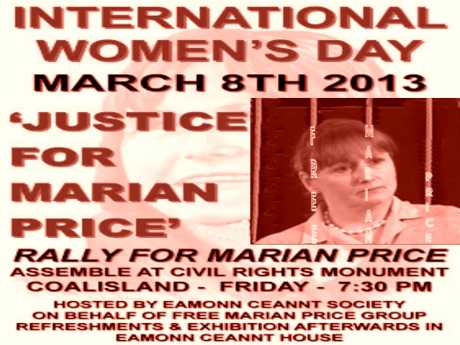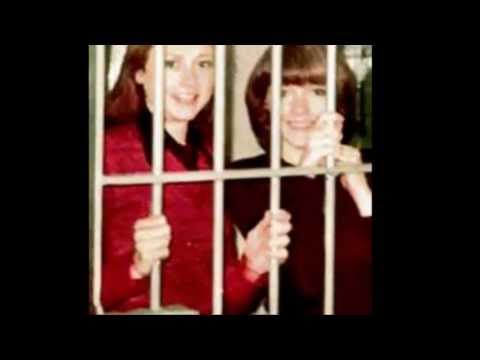Thursday January 01 1970
March For Marian Price on International Women's Day
 international |
rights, freedoms and repression |
event notice
international |
rights, freedoms and repression |
event notice  Thursday February 14, 2013 10:58
Thursday February 14, 2013 10:58 by BrianClarke - AllVoices
by BrianClarke - AllVoices
On the 4th of January, 1969 Irish civil rights protesters from People's Democracy which included the Price sisters suffered a brutal attack from around 200 lyalists armed with iron bars, bottles and stones at Burntollet Bridge in a march from Belfast to Derry. It is an important day in history in that for many, in that it was the start of the troubles in Ireland with a number of young women savagely beaten which included the price sisters. Beaten into the river, it was a baptism of fire for the two young teenagers.
The march was repeatedly attacked by loyalists including off-duty members of the British forces along its route.The march was based on the Selma-Montgomery march in Alabama in 1966, which had exposed the racist thuggery of America's deep South and forced the US government into major reforms. This march exposed the the deep rooted sectarianism of British mentored loyalism which is still, vindictively, politicall, interning Marian. The following are some marchers recounting their experiences.
"Available police forces did not provide adequate protection to People's Democracy marchers at Burntollet Bridge and in or near Irish Street, Londonderry (sic) on 4th January 1969. There were instances of police indiscipline and violence towards persons unassociated with rioting or disorder on 4th/ 5th January in Londonderry (sic) and these provoked serious hostility to the police, particularly among the Catholic population of Londonderry (sic), and an increasing disbelief in their impartiality towards non-Unionists.
"Loyalists viewed the People's Democracy and the march as another attempt to undermine the Unionist government of Northern Ireland. A number of leading Loyalists, including Ronald Bunting and Ian Paisley, had indicated in advance of the march that they would be calling on 'the Loyal citizens of Ulster' to 'harrass and harry' the four-day march.
"On each day of the march groups of Loyalists confronted, jostled, and physically attacked those taking part in the march. At no time did the Royal Ulster Constabulary (RUC), who were accompanying the march, make any effort to prevent these attacks. The most serious incidents occurred on the last day between Claudy and Derry. The march was ambushed at Burntollet Bridge by approximately 200 Loyalists, including off-duty members of the 'B-Specials', and 13 marchers required hospital treatment. The march was again attacked as it passed through the Waterside area of Derry. Later in the evening members of the RUC attacked people and property in the Bogside area of Derry sparking several days of serious rioting.
"The way in which the police mishandled the People's Democracy march confirmed the opinion of many Catholics that the RUC could not be trusted to provide impartial policing in Northern Ireland. The events also further alienated many in the Catholic population from the Northern Ireland state. The march also marked the point where concerns about civil rights were beginning to give way to questions related to national identity and the constitutional position of Northern Ireland."
"The repeated refrain 'up to our knees in Fenian blood' seemed a little ominous to me" - Eddie Toman
"I saw people, including one man who was standing with an armful of stones against his chest on the lower ground to the left of the field. Suddenly, I heard screams coming from behind, and looking around saw a shower of stones in the air. The march scattered in some panic; then I saw a girl being put onto a police tender with blood pouring from her head. Then I saw a television cameraman with blood streaming down his face" - John Gilmore, Belfast student
"The major portion of the C.R. procession was cut off and left at the mercy of the attackers. A fusillade of stones and bottles was followed by the full weight of the attack against the young men and women who had pledged themselves to a policy of non-violence.
"The attackers showed no mercy. Men were beaten senseless. Girls tore their way through the hedges screaming: 'No! No!' Shouting, club-waving, men pursued them." -Description from the Irish News of the time.
"I saw the police moving through the fields, and then I saw the first attacker wearing a white armband. Then I began to see other men wearing similar armbands standing in groups on high ground along the road. I remember then dismissing the idea that the attackers would simply be angry groups of locals annoyed at demonstrators passing through their village. My impression now was that the attack was well organised, and the armbands were for recognition purposes.
"By now the field seemed crowded with men and youths, perhaps 100 or 150. I saw some women and girls, too, among the people in the field. I saw the police marshalling a girl along in the field. She carried two milk bottles in her hand. Then I saw the first stone come whizzing through the air and remember shouting to the people near me to get in against the hedge. In a second the air was thick with missiles. I pulled my coat up around my head and crouched down, stumbling forward. There was utter confusion as girls screamed, and stones and bottles crashed around. I kept my head down but on once looking up I saw another large group of men with cudgels and sticks running onto the road ahead of us.
"There was tremendous confusion as people stumbled and grabbed each other for cover and protection." - Teacher
"I then saw a girl with a white, furry hat being confronted by a Paisleyite with a wooden club. The hat was taken off and she received two blows each followed by blood." - Cohn Moore from Belfast
"Showers of rocks crashed round us. I was in the middle of the fourth row and bent double in an attempt to avoid the hail of missiles, when a middle-aged man in a tweed coat, brandishing what seemed to be a chair leg dashed from the left-hand side of the road, hit me on the back, then pulled down the hood of my anorak and struck me on the head. I then tried to crawl away, but, teeth bared, he hit me again on the spot on my skull . . . I fell, and a fellow marcher picked me up and dragged me up the road; I passed out, and came round in the ambulance on the way to Alnagelvin Hospital" -Mrs. Judith McGuffin, a schoolteacher from Belfast
"I passed through the hail of stones, being hit only once on the leg. When we crossed the bridge I turned back because my three sons were in the march, and I wanted to find them. Standing on the side of the bridge to the marchers' left, was a large, middle-aged, well dressed man, leaning against the bridge wall quite casually. As a line of marchers passed he whipped what seemed like a police baton out of his overcoat pocket and smashed it on the back of the nearest marcher. Boys and girls went down, one after another" - Mrs. Margaret Tracey, a fifty-four year-old housewife, Dungiven.
Caption: Video Id: 4KcoF5RbuEQ Type: Youtube Video
Dolores Price. IRA Freedom Fighter

